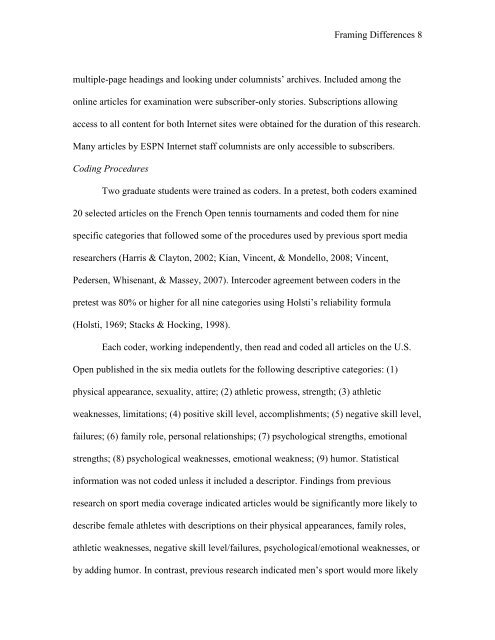Framing Differences 1 Framing Differences in Gender-Related Sport ...
Framing Differences 1 Framing Differences in Gender-Related Sport ...
Framing Differences 1 Framing Differences in Gender-Related Sport ...
- No tags were found...
You also want an ePaper? Increase the reach of your titles
YUMPU automatically turns print PDFs into web optimized ePapers that Google loves.
<strong>Fram<strong>in</strong>g</strong> <strong>Differences</strong> 8multiple-page head<strong>in</strong>gs and look<strong>in</strong>g under columnists’ archives. Included among theonl<strong>in</strong>e articles for exam<strong>in</strong>ation were subscriber-only stories. Subscriptions allow<strong>in</strong>gaccess to all content for both Internet sites were obta<strong>in</strong>ed for the duration of this research.Many articles by ESPN Internet staff columnists are only accessible to subscribers.Cod<strong>in</strong>g ProceduresTwo graduate students were tra<strong>in</strong>ed as coders. In a pretest, both coders exam<strong>in</strong>ed20 selected articles on the French Open tennis tournaments and coded them for n<strong>in</strong>especific categories that followed some of the procedures used by previous sport mediaresearchers (Harris & Clayton, 2002; Kian, V<strong>in</strong>cent, & Mondello, 2008; V<strong>in</strong>cent,Pedersen, Whisenant, & Massey, 2007). Intercoder agreement between coders <strong>in</strong> thepretest was 80% or higher for all n<strong>in</strong>e categories us<strong>in</strong>g Holsti’s reliability formula(Holsti, 1969; Stacks & Hock<strong>in</strong>g, 1998).Each coder, work<strong>in</strong>g <strong>in</strong>dependently, then read and coded all articles on the U.S.Open published <strong>in</strong> the six media outlets for the follow<strong>in</strong>g descriptive categories: (1)physical appearance, sexuality, attire; (2) athletic prowess, strength; (3) athleticweaknesses, limitations; (4) positive skill level, accomplishments; (5) negative skill level,failures; (6) family role, personal relationships; (7) psychological strengths, emotionalstrengths; (8) psychological weaknesses, emotional weakness; (9) humor. Statistical<strong>in</strong>formation was not coded unless it <strong>in</strong>cluded a descriptor. F<strong>in</strong>d<strong>in</strong>gs from previousresearch on sport media coverage <strong>in</strong>dicated articles would be significantly more likely todescribe female athletes with descriptions on their physical appearances, family roles,athletic weaknesses, negative skill level/failures, psychological/emotional weaknesses, orby add<strong>in</strong>g humor. In contrast, previous research <strong>in</strong>dicated men’s sport would more likely





